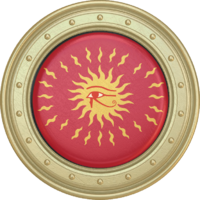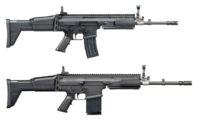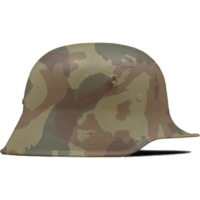Military of the Suren Confederacy
| Surenid Armed Forces | |
 Emblem of the former Popular Levy, adopted in 1692 AN following the incorporation of the Suren into the Raspur Pact. | |
| Country |
|
|---|---|
| Founded | |
| Branches | Defence Force |
| Headquarters | Surenshahr |
| Leadership | |
| Surenšāh | Mitradokht of Suren |
| Euramehr Arteshbod | Ardashir Ghul |
| Manpower | |
| Military age | 18–65 years old |
| Conscription | Yes |
| Active personnel | 313,080 |
| Reserve personnel | 292,595 |
History
One interesting aspect with the Surenids, first attested during the Second Euran War, was their disinclination to hold captives as prisoners of war for an extended period of time. Excepting those sent back for further interrogation by the gendarmes, those branded for the attention of the judicial authorities, or those summarily executed at the discretion of the commander of the local forces, captives taken by the Surenid forces would be released and sent back towards their own lines at the earliest opportunity. The macabre detail to note however is that those released in this manner would first be subjected to the amputation of their right hand and left foot. The bloody stumps resulting from these operations being cauterised by the heated blade of a knife, followed by the application of a coat of tar mixed with sand. Those wishing to avoid being released from captivity in this fashion were obliged to accept the Surenshah's salt and enter into his service as kuls under a Life-Service Bond.
Long beset by equipment shortages, the Suren were almost pathetically grateful when in 1690 AN the agents of the State Gendarmerie were able to negotiate the seizure of the Krasnocorian arsenal formerly held in Port Ulje in return for offering the garrison there, marooned for five years since the collapse of their home country, generous cash payments, humanitarian relief supplies, and the opportunity to resettle in Surenid territory.
At the same time more concerted efforts were made to identify, catalogue and salvage repairable pieces of equipment left over from the Euran Wars. To this assemblage of arms was added a steady flow of military aid received from Constancia and New Alexandria under the Fontainebleau Accords and subsequently from Trans-Euran Command following the accession of the Confederacy to the Raspur Pact. The outbreak of the Third Euran War (1693 AN–1701 AN) would see further donations of equipment, particularly in the form of light attack aircraft for counter-insurgency operations, and the embedding of advisors from the Constancian Foreign Legion in the State Gendarmerie.
The breadth of the conflict with Zeed, encompassing guerrilla warface, counter-insurgency operations, and finally full-scale manoeuvre warfare, exceeded the capacity of the State Gendarmerie, even when reinforced by mobilised reserve elements of the Popular Levy. In spite of the Mobilisation Act of 1695 and the 1697 Impressment Act, the Surenids struggled to meet their manpower requirements, and indeed the bulk of the army that was eventually taken south into Zeedic territory after 1698 AN, following in the wake of a Constancian offensive which overwhelmed the Ḡur Republic, comprised of mercenaries, kul slave soldiers, and retainers taken from the Royal Court.
Following the surrender of Zeed in 1701 AN, the surviving armaments of the Revolutionary Armed Forces were transferred by Trans-Euran Command to the Suren Confederacy as part of the reparations owed by Zeed as the aggressor in the conflict.
In spite of being sorely tested during the conflict with Zeed, the Popular Levy did not undergo meaningful reform in the following two decades and in consequence struggled to suppress the Kapavian insurgency and ultimately failed to reconquer the greater part of formerly Bassarid Norasht during Operation Jungle Bolo. On both occasions the Surenid had been obliged to stave off collapse through the widespread use of kuls and subjects pressed into service. Moreover the Surenid had only been able to sustain themselves at all through massive allied interventions staged by the Raspur Pact, most notably by the Benacian Union, Constancia, Floria, and Nouvelle Alexandrie. By 1718 AN it was increasingly apparent that, in order to cease to be regarded as a liability by the Raspur Pact, the military of the Suren Confederacy would have to undergo a wide-ranging process of reform and modernisation.
In order to prepare for the reorganisation process, which would see the Popular Levy replaced in the national defence role by the Surenid Armed Forces, a professionalised and all-volunteer force, over the course of 1718 AN – 1720 AN, the mission of defending the Norashti frontier would be vested in the hands of the Lashkar-e-Yazatá, the Constancian Home Guard, and the Benacian Eura Corps fielded by the Benacian Union Defence Force and Local Auxiliary Franchises. This process would necessitate the permanent establishment of the Popular Levy and the Gendarmes would be assigned to training camps overseen by military missions invited from member-states of the Raspur Pact. These national missions were as follows:
 Benacian Union: Armoured Warfare
Benacian Union: Armoured Warfare Constancia: Naval warfare
Constancia: Naval warfare Floria: Infantry
Floria: Infantry Nouvelle Alexandrie: Area Defence (artillery, air-defence, surveillance, UAVs etc)
Nouvelle Alexandrie: Area Defence (artillery, air-defence, surveillance, UAVs etc) Shireroth: Aerial warfare
Shireroth: Aerial warfare
The Surenid Armed Forces received an additional assistance package in the form of 32x F-8 Shrike multi-role strike aircraft donated by Sanama. The donation was accompanied by a training mission of deployed personnel from the Sanaman Union Air Force, whose presence was deemed necessary as the Surenid cadre of trained aviators had next to no prior experience in the operation and maintenance of fast jet aircraft.
Commanders
- Euramehr Arteshbod
Structure
- Armed Forces of the Suren Confederacy
- General Headquarters of the Armed Forces
- Chief of Staff
- Deputy Chief of Staff for Plans, Policy, and Operations
- Deputy Chief of Staff for Personnel and Logistics
- Deputy Chief of Staff for Intelligence
- Deputy Chief of Staff for Information Operations
- Deputy Chief of Staff for Communications
- Deputy Chief of Staff for Budget and Programs
- Joint Public Affairs Office
- Command Sergeant Major
- General Service Regiment
- Transportation Regiment
- Security Squadron
- General Inspectorate
- Army Inspectorate
- Training and Doctrine Command
- Personnel and Logistics Command
- Discipline Command
- Army Inspectorate Security Brigade
- Naval Inspectorate
- Training and Doctrine Command
- Personnel and Logistics Command
- Discipline Command
- Naval Inspectorate Security Brigade
- Air Force Inspectorate
- Training and Doctrine Command
- Personnel and Logistics Command
- Discipline Command
- Air Inspectorate Security Brigade
- Army Inspectorate
- Commissariat
- Quartermaster's Regiment
- Medical Corps
- Medical Regiment
- Veterinary Regiment
- Dental Regiment
- Logistics Corps
- Ordnance Regiment
- Supply Regiment
- 1st Transport (Motorized Wagon) Regiment
- 2nd Transport (Camel) Regiment
- 3rd Transport (Mule & Onager) Regiment
- Electrical and Mechanical Engineering Regiment
- Naval Logistics Group
- Fleet Support Regiment
- Port Services Regiment
- Air Logistics Group
- Base Support Regiment
- Aircraft Maintenance Regiment
- Military Intelligence Organisation
- Intelligence Director's Office
- Signals Intelligence Squadron
- Counter-Intelligence Squadron
- Human Intelligence Squadron
- Imagery Intelligence Squadron
- Open-Source Intelligence Squadron
- Technical Support Squadron
- Chief of Staff
- General Headquarters Land Forces
- 1st Command and Control Regiment
- I Corps
- 1st Infantry Division
- 2nd Infantry Division
- 6th Artillery Division
- II Corps
- 3rd Infantry Division
- 4th Infantry Division
- 5th Armoured Division
- 4th Command & Control Regiment
- Armoured Demi-Brigade
- Area Defence Demi-Brigade
- Grenadier Demi-Brigade
- Commissariat Regiment
- Inspectorate Regiment
- Artillery Siege Train
- Air Defence Division
- Logistical Corps
- Supply and Transport Division
- Ordnance Division
- Medical Division
- 7th Cavalry Division
- Admiralty
- 2nd Command and Control Regiment
- Royal Yacht Squadron
- Surface Combatant Command Division, with a total of 14 ships:
- 1st Flotilla (2 Amphibious Landing Platform Docks)
- 2nd Flotilla (8 Frigates)
- 3rd Flotilla (4 Corvettes)
- Naval Aviation Wing (2 transport aircraft)
- Coastal Command Division, with a total of 72 boats:
- 1st Flotilla (24 armed trawlers, armed yachts, and coastal patrol craft)
- 2nd Flotilla (24 armed trawlers, armed yachts, and coastal patrol craft)
- 3rd Flotilla (24 armed trawlers, armed yachts, and coastal patrol craft)
- Air Command
- 3rd Command and Control Regiment
- Fighter Division (96 F-9 Ashavan II)
- Strike Division (32 F-8 Shrikes, 16 Buzzard C-61 fighter-bombers, 48 F-9 Ashavan II)
- Army Cooperation Division (24 C-11 Mula, 12 liaison planes)
- Maritime Patrol Division (12 maritime patrol aircraft)
- Air Defence Division (72 F-9 Ashavan II, 16 Buzzard C-61 interceptor aircraft, 12 ground-based radar stations, 48 surface-to-air missile batteries, 96 anti-aircraft guns)
- Air Training Division (24 trainer aircraft)
- General Headquarters of the Armed Forces
Equipment
Land
Armoured vehicles
| Name | Origin | Type | Quantity | Image | Notes |
|---|---|---|---|---|---|
| Main Battle Tanks | |||||
| "Babak" | Main battle tank | 130 |  |
| |
| "Rashid" | Main Battle Tank | 30 |  |
| |
| Armoured Fighting Vehicles | |||||
| "Rustam" (WNFV 100 MBT) | Light Tank | 848 |  |
||
| "Rakesh" (WNFV 101 IFV) | Infantry Fighting Vehicle | 700 |  |
||
| Armoured Personnel Carriers | |||||
| "Bahram" | Mine-Resistant Ambush Protected Vehicle | 12,694 |  |
||
| "Sohrab" (WNFV 102 APC) | Armoured Personnel Carrier | 4,723 |  |
||
| "Kay Kavus" (WNFV 102A CV) | Command Vehicle | 96 |  |
||
| "Siyavysh" (WNFV 102B IMV) | Infantry Mobility Vehicles | 1,273 |  |
||
| Armoured Reconnaissance Vehicles | |||||
| "Kay Khusrow" (WNFV 101A ARV) | Armoured Reconnaissance Vehicle | 1,177 |  |
||
Artillery
| Name | Origin | Type | Quantity | Image | Notes |
|---|
Infantry equipment & weaponry
| Name | Origin | Type | № in Service | Image | Notes |
|---|---|---|---|---|---|
| Equipment | |||||
| Personal weapons | |||||
| FBP RAP 7.62mm assault rifle | Assault rifle | 10,000 |  |
10,000x purchased, 1722 AN. | |
| M1581 7.62 mm Machine Carbine | Carbine | 52,842 |  |
| |
| M1591 7.62 mm Rifle |
|
403,171 |
| ||
| M1656 9 mm SMG | Submachine Gun | 134,328 |  |
| |
| M1686 assault rifle (7.62×67mmB) | Service rifle | 33,233 |  |
| |
| M1690 machine pistol (9x19mm) | Machine pistol | 1,911 | 8,000x obtained under the Fontainebleau Accords of 1691 AN, of which 1,911 remained by 1722 AN. | ||
| SA1680 | Assault Rifle | 14,391 | |||
| Squad weapons | |||||
| Troop weapons | |||||
| Squadron weapons | |||||
| Protective Equipment & Body Armour | |||||
| M1639 Stahlhelm | Steel Helmet | 840,000 |  |
Purchased and delivered as military aid from the Benacian Union, 1718 AN–1722 AN | |
| Uniforms | |||||
Support vehicles
| Name | Origin | Type | Quantity | Image | Notes |
|---|

